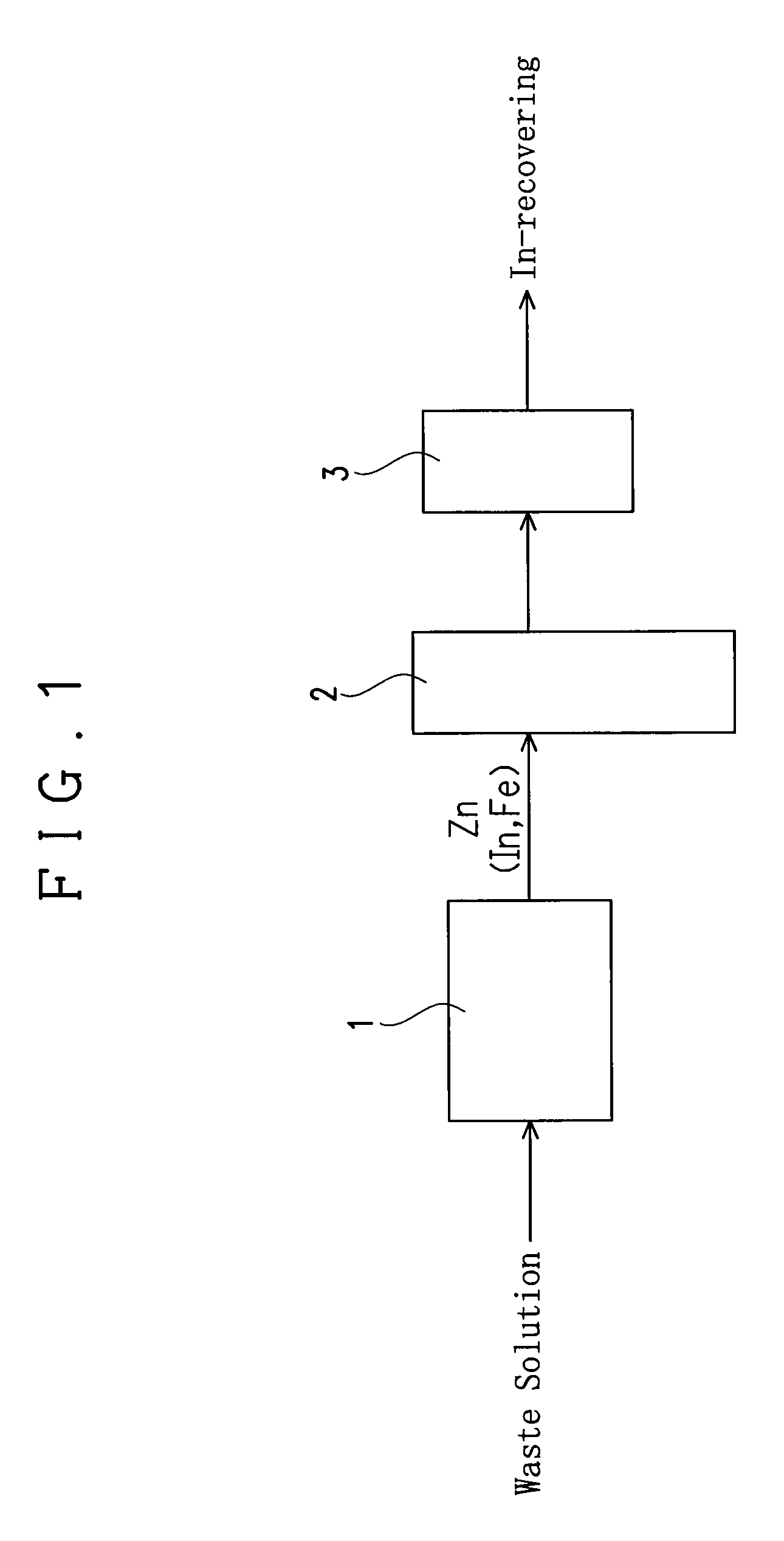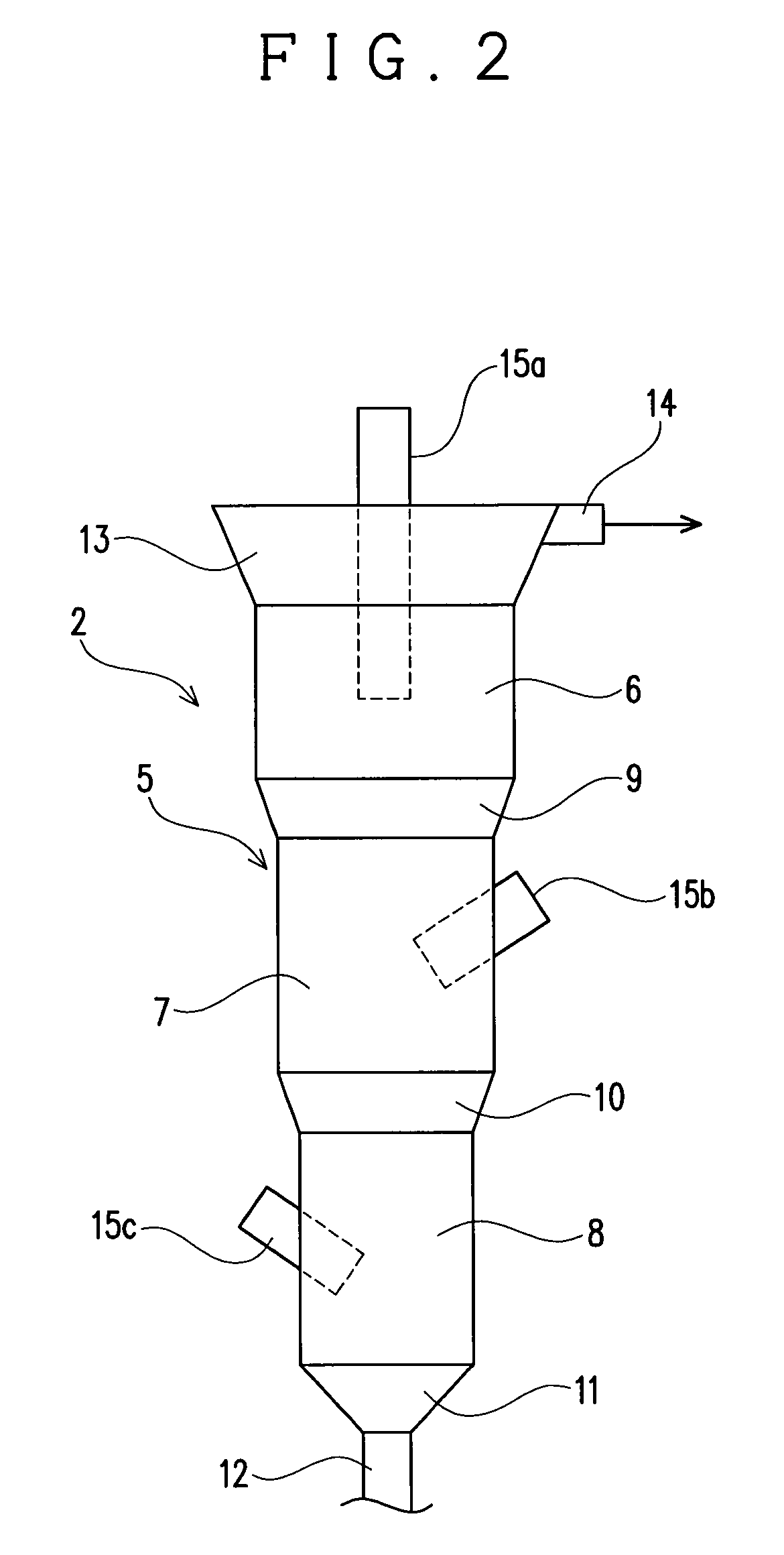Method and apparatus for recovering indium from etching waste solution containing indium and ferric chloride
a technology of indium and ferric chloride, which is applied in the direction of moving filter element filters, filtration separation, separation processes, etc., can solve the problems of not recovering metals as valuables, increasing the amount of hydroxide generated as a whole, etc., and achieves the effect of increasing the total surface area of metals, improving recovery efficiency, and increasing ionization tendency
- Summary
- Abstract
- Description
- Claims
- Application Information
AI Technical Summary
Benefits of technology
Problems solved by technology
Method used
Image
Examples
embodiment 1
[0033]An apparatus of this embodiment for recovering indium (In) from an etching waste solution containing indium and ferric chloride is provided with a reaction vessel 1, a fluidizing apparatus and a filter 3 as shown in FIG. 1.
[0034]The reaction vessel 1 serves to receive an etching waste solution to immerse a precipitation-inducing metal in the etching waste solution and to allow to stand, thereby causing a reaction for precipitating In from the waste solution by the cementation reaction (metal precipitation reaction) based on a difference in ionization tendency between the precipitation-inducing metal and indium as explained later. A columnar one having a diameter of 3.5 mm and a length of 3.5 mm and including zinc (Zn) is used as the precipitation-inducing metal in this embodiment.
[0035]The fluidizing apparatus 2 serves to fluidize the precipitation-inducing metal with In precipitated thereon in a solution to detach the In precipitated on the precipitation-inducing metal. The f...
embodiment 2
[0056]This embodiment is different from the embodiment 1 in the structure of the apparatus body 5. Specifically, in this embodiment, an apparatus body 5, as shown in FIG. 3, has a structure in which the entire peripheral surface forms a taper spread upward, so that the sectional area of the apparatus body 5 is increased continuously with decrease in distance from the top of the apparatus body 5. This embodiment 2 is different in this point from the embodiment 1 in which the sectional area of the apparatus body 5 is discontinuously increased with decrease in distance from the top of the apparatus body 5. Since the apparatus body 5 of the this embodiment is structured such that it is not discontinuously but continuously increased in its sectional area, the apparatus body 5 of this embodiment is not divided into the apparatus upper part 6, the apparatus middle part 7 and the apparatus lower part 8 in its structure unlike the embodiment 1.
[0057]However, this embodiment is in common with...
embodiment 3
[0059]In this embodiment, as shown in FIG. 4, a dissolving vessel 4 is installed on the downstream side of the reaction vessel 1 and the upstream side of the fluidizing apparatus 2, and this embodiment differs in this point from the embodiment 1 provided with no dissolving vessel 4.
[0060]Specifically, in this embodiment, the precipitation-inducing metal which includes Zn and on which In and Fe have been precipitated in the reaction vessel 1 is not directly supplied to the fluidizing apparatus 2 to detach an alloy of In and Fe, but is supplied to the dissolving vessel 4 to dissolve In and Fe precipitated on the precipitation-inducing metal in the dissolving vessel 4. The dissolved In and Fe are again precipitated in the fluidizing apparatus 2. For this, the fluidizing apparatus 2 has not only a function of fluidizing the precipitation-inducing metal to detach an alloy of In and Fe but also a function as a reactor that precipitates In and Fe dissolved in the dissolving vessel 4, again...
PUM
| Property | Measurement | Unit |
|---|---|---|
| length | aaaaa | aaaaa |
| longitudinal length | aaaaa | aaaaa |
| longitudinal length | aaaaa | aaaaa |
Abstract
Description
Claims
Application Information
 Login to View More
Login to View More - R&D
- Intellectual Property
- Life Sciences
- Materials
- Tech Scout
- Unparalleled Data Quality
- Higher Quality Content
- 60% Fewer Hallucinations
Browse by: Latest US Patents, China's latest patents, Technical Efficacy Thesaurus, Application Domain, Technology Topic, Popular Technical Reports.
© 2025 PatSnap. All rights reserved.Legal|Privacy policy|Modern Slavery Act Transparency Statement|Sitemap|About US| Contact US: help@patsnap.com



